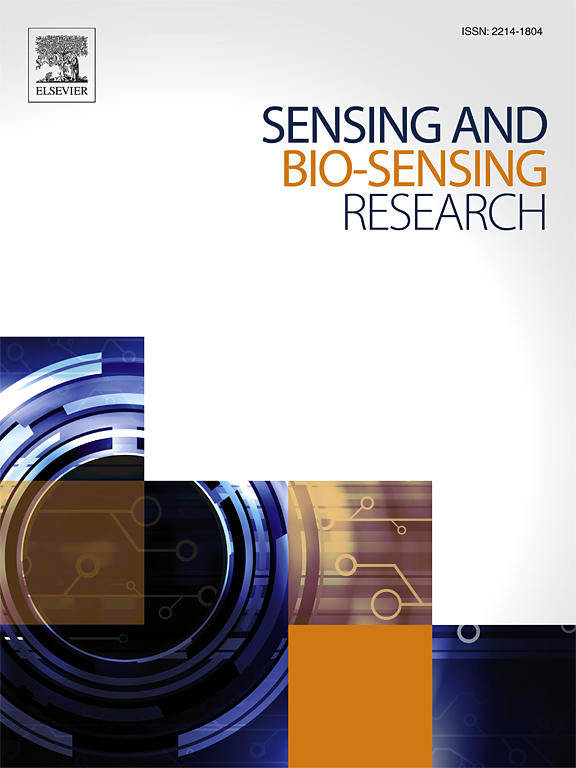Application of novel oligomeric Co(II) complexes of 4,4′-bipyridine and 1,10-phenanthroline modified glassy carbon electrode for differential pulse voltammetric determination of ciprofloxacin
IF 5.4
Q1 CHEMISTRY, ANALYTICAL
引用次数: 0
Abstract
Two new oligomer mixed ligand complexes, comprising 21 ([Co21(phen)42(bipy)21]Cl42 (C2)) and 100 monomer units ([Co100(phen)200(bipy)100]Cl200 (C3)) were synthesized. These complexes, designated as [Co21(phen)42(bipy)21]Cl42 (C2) and [Co100(phen)200(bipy)100]Cl200 (C3), were employed for the modification of a glassy carbon electrode (GCE) to detect ciprofloxacin (CPF) in tablet formulations and human urine samples. By potentiodynamic deposition, the modified electrodes (poly(C2)/GCE) and (poly(C3)/GCE) were prepared, forming a conductive electroactive film on the GCE surface. The modified electrodes were characterized using cyclic voltammetry and electrochemical impedance spectroscopy, which revealed an increased effective surface area and a significant reduction in charge transfer resistance of the electrode. An oxidative peak at a lower potential with a six-fold increase in peak current was observed at the poly(C2)/GCE. The absence of a reductive peak in the reverse scan indicated the irreversibility of the electrochemical oxidation of CPF. The correlation coefficient between the peak current and the square root of the scan rate indicated that CPF oxidation at the poly(C2)/GCE was primarily controlled by diffusion mass transport. With a detection limit of 3.4 × 10−9 M, the voltammetric current response of CPF at the poly(C2)/GCE under optimal circumstances showed a linear trend with concentrations ranging from 5.0 × 10−8 to 2.0 × 10−4 M. It was discovered that the CPF levels in the examined tablet brands fell between 98.35 % and 101.30 % of their stated ranges. The recovery results for tablet and urine samples ranged from 99.44 % to 99.95 % and 99.25 % to 100.51 %, respectively, with interference recovery showing an error of less than 4.73 %. When it came to determining CPF in tablet formulations and human urine samples, the new approach outperformed recently published voltammetric methods. This superiority can be attributed to the simplicity of the electrode modification step, the lowest limit of detection, and a reasonably wide linear dynamic range.
新型4,4′-联吡啶和1,10-菲罗啉低聚Co(II)配合物修饰玻碳电极在差分脉冲伏安法测定环丙沙星中的应用
合成了21([Co21(phen)42(bipy)21]Cl42 (C2))和100个单体([Co100(phen)200(bipy)100]Cl200 (C3))两个新的低聚体混合配体配合物。这些配合物被命名为[Co21(phen)42(bipy)21]Cl42 (C2)和[Co100(phen)200(bipy)100]Cl200 (C3),用于修饰玻璃碳电极(GCE)来检测片剂配方和人尿样品中的环丙沙星(CPF)。通过动电位沉积法制备了修饰电极(poly(C2)/GCE)和(poly(C3)/GCE),在GCE表面形成导电的电活性膜。利用循环伏安法和电化学阻抗谱对修饰后的电极进行了表征,结果表明电极的有效表面积增加,电荷转移电阻显著降低。在聚(C2)/GCE上观察到低电位下的氧化峰,峰值电流增加了6倍。在反扫描中没有还原峰,表明CPF的电化学氧化是不可逆的。峰值电流与扫描速率平方根的相关系数表明,聚(C2)/GCE的CPF氧化主要受扩散传质控制。CPF的检出限为3.4 × 10−9 M,在最佳条件下,CPF在聚(C2)/GCE上的伏安电流响应在浓度范围为5.0 × 10−8 ~ 2.0 × 10−4 M范围内呈线性变化,在所检测的片剂中CPF的含量在规定范围的98.35% ~ 101.30%之间。对片剂和尿样的回收率分别为99.44% ~ 99.95%和99.25% ~ 100.51%,干扰回收率小于4.73%。当涉及到测定片剂配方和人类尿液样本中的CPF时,新方法优于最近发表的伏安法。这种优势可以归因于电极修饰步骤的简单性,最低的检测限,以及相当宽的线性动态范围。
本文章由计算机程序翻译,如有差异,请以英文原文为准。
求助全文
约1分钟内获得全文
求助全文
来源期刊

Sensing and Bio-Sensing Research
Engineering-Electrical and Electronic Engineering
CiteScore
10.70
自引率
3.80%
发文量
68
审稿时长
87 days
期刊介绍:
Sensing and Bio-Sensing Research is an open access journal dedicated to the research, design, development, and application of bio-sensing and sensing technologies. The editors will accept research papers, reviews, field trials, and validation studies that are of significant relevance. These submissions should describe new concepts, enhance understanding of the field, or offer insights into the practical application, manufacturing, and commercialization of bio-sensing and sensing technologies.
The journal covers a wide range of topics, including sensing principles and mechanisms, new materials development for transducers and recognition components, fabrication technology, and various types of sensors such as optical, electrochemical, mass-sensitive, gas, biosensors, and more. It also includes environmental, process control, and biomedical applications, signal processing, chemometrics, optoelectronic, mechanical, thermal, and magnetic sensors, as well as interface electronics. Additionally, it covers sensor systems and applications, µTAS (Micro Total Analysis Systems), development of solid-state devices for transducing physical signals, and analytical devices incorporating biological materials.
 求助内容:
求助内容: 应助结果提醒方式:
应助结果提醒方式:


